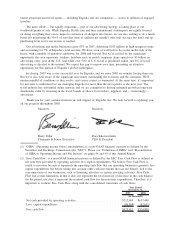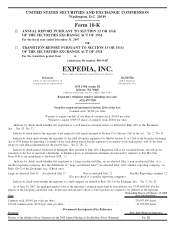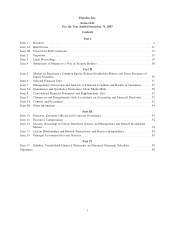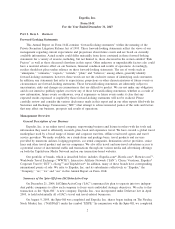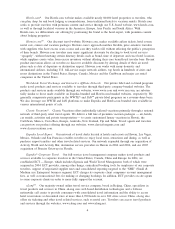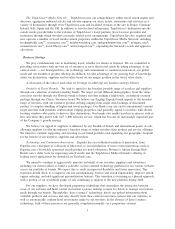Expedia 2007 Annual Report Download - page 13
Download and view the complete annual report
Please find page 13 of the 2007 Expedia annual report below. You can navigate through the pages in the report by either clicking on the pages listed below, or by using the keyword search tool below to find specific information within the annual report.and for such bookings, we are the merchant of record. Under the agency model, we act as an agent in the
transaction, passing reservations booked by our travelers to the relevant airline, hotel, car rental company or
cruise line.
As merchant of record, we generally have certain latitude to establish prices charged to travelers (as
compared to agency transactions). Also, we negotiate inventory allocation and pricing with our suppliers which
enables us to achieve a higher level of net revenue per transaction as compared to those provided through the
agency model.
Through our Expedia-branded websites, travelers can dynamically assemble multiple component travel
packages in a single transaction at a lower price as compared to booking each component separately. Packages
assembled by travelers through the packaging model on these websites include a merchant hotel component
and an air or car component. Travelers select packages based on the total package price, without being
provided component pricing. The use of the merchant travel components in packages enables us to make
certain travel products available at prices lower than those charged on an individual component basis by travel
suppliers without impacting their established pricing and position models. We are also expanding our use of
third-party provided pre-assembled package offerings, particularly through our international points of sale,
further broadening our scope of products and services to travelers.
Our agency business is comprised of the sale of airline tickets, hotel, cruise and car rental reservations.
Airline ticket transactions make up the majority of this business. Although net revenue per transaction is lower
compared to the merchant model, due to the high volume of airline tickets sold our agency gross bookings
accounted for 58% of total gross bookings for the year ended December 31, 2007.
Relationships with Travel Suppliers, Distribution and Fulfillment Partners
Overview. We make travel products and services available from a variety of large and small commercial
and charter airlines, lodging properties, car rental companies, cruise lines and destination service providers.
We seek to build and maintain long-term, strategic relationships with travel suppliers and global distribution
system (“GDS”) partners. An important component of the success of our business depends on our ability to
maintain our existing, as well as build new, relationships with travel suppliers and GDS partners.
Travel Suppliers. We strive to deliver value to our travel suppliers through a wide range of innovative,
targeted merchandising and promotional strategies designed to increase their revenue, while simultaneously
reducing their marketing transaction and customer service costs. Our Partner Services Group consists mainly
of strategic account managers and local market managers who work directly with travel suppliers to increase
the marketing of their travel products and brands through our points of sale, including participation in our
seasonal and event-driven promotions.
In addition, we have developed proprietary, supplier-oriented technology that streamlines the interaction
between some of our websites and hotel central reservation systems, making it easier and more cost-effective
for hotels to manage reservations made through our brands. Through this “direct connect” technology, hotels
can upload information about available products and services and rates directly from their central reservation
systems into our websites, as well as automatically confirm hotel reservations made by our travelers. In the
absence of direct connect technology, both of these processes are generally completed manually via a
proprietary extranet. Our travelers can now book reservations with over 35,000 merchant hotel properties
worldwide, of which over 45% are now fully direct-connected.
Distribution Partners. GDSs, also referred to as computer reservation services, provide a centralized,
comprehensive repository of travel suppliers “content” — such as availability and pricing of seats on various
airline point-to-point flights, or “segments.” The GDSs act as intermediaries between the travel suppliers and
travel agencies, allowing agents to reserve and book flights, rooms or other travel products.
While we historically used Worldspan as our primary GDS, in light of the deregulated GDS environment
and our desire to ensure the widest possible supply of air content for our travelers, we diversified our use of
GDS providers in 2006 and 2007 by adding distribution agreements with Sabre and Amadeus, who are now
our primary segment providers.
7



